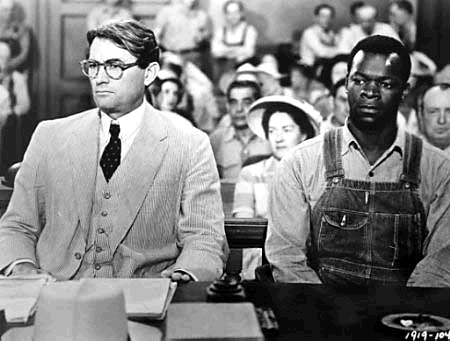 |
| To Kill a Mockingbird: Atticus Finch and Tom Robinson |
The
Sixth Amendment of the United States Constitution grants criminal defendants the right to counsel in federal cases. In 1963 the Supreme Court extended this right to state felony prosecutions in the landmark case
Gideon v. Wainwright. Twenty-one years after
Gideon, the Supreme Court in
Strickland v. Washington held that the right to counsel really means the right to
effective assistance of counsel. Generally speaking,
ineffective assistance of counsel (IAC) can be defined as errors by counsel so severe in nature that the criminal defendant was denied a fair trial.
Strickland provides a specific test. Under
Strickland, a defendant must establish: (1) their trial lawyer’s performance fell short of an “objective standard of reasonableness” and (2) “a reasonable probability that, but for counsel’s unprofessional errors, the result of the proceeding would have been different.”
The right to effective assistance of counsel obviously is important for criminal practitioners and for law students who wish to enter the field. This post will provide three instances in which IAC claims are commonly brought, as well as analysis and advice on what does and does not constitute IAC in those situations. The three instances are: inexperience of counsel; counsel’s failure to search for mitigating evidence in penalty phases of murder trials; and counsel’s failure to object to the requirement that the defendant wear restraints in front of the jury.
In
U.S. v. Bergman, a recent Tenth Circuit case, Gwen Bergman pled guilty to violating federal law after she paid $30,000 to a undercover law enforcement agent posing as a hit man to murder her ex-husband. Bergman, though, later discovered her counsel had never been a licensed attorney. The Tenth Circuit held that it was
per seIAC when a “man claiming to have been successfully admitted to the bar, but who never attended law school or even graduated from college” and was a convicted felon represented a criminal defendant. However, nervous, fledgling lawyers should not be worried: The Seventh Circuit (albeit before
Strickland) has held that the “mere inexperience of trial counsel” does not by itself establish IAC.
Referencing Shakespeare, the court noted “Portia without experience was a remarkably successful representative of Antonio” to make the point that the lawyer’s actions, not experience, determine the effectiveness of their counsel.
While this is a
somewhat lighthearted example, it is important to note that IAC claims commonly arise after a defendant has been convicted of and sentenced for murder. Often, the issue is whether counsel performed a reasonable investigation into mitigating evidence for a defendant’s penalty phase of his or her murder trial.
For example, in
Wiggins v. Smith, the Supreme Court held that defense counsel’s decision to limit the investigation looking for mitigating evidence to the presentence investigation reports and social services records fell short of prevailing standards in capital cases and thus constituted IAC.
In contrast, counsel’s decision in
Strickland to not seek out character witnesses or request a psychiatric evaluation was not IAC. One of the lessons from these cases is that a
Strickland analysis is very fact-specific:
in Strickland the murders were especially brutal, less mitigating evidence was available, and the defendant acted against counsel’s advice by confessing to two murders and waiving his right to a jury trial, making his situation “hopeless”;
in Wiggins, on the other hand, “[t]he mitigating evidence counsel failed to discover and present [was] powerful” as the defendant had an “excruciating life history” which counsel failed to explore and introduce.
IAC claims also can arise when a defendant is convicted of murder after a trial in which he or she was wearing restraints in front of the jury. In a recent Alabama federal district case, Geoffrey Todd West, found guilty at trial of capital murder during the course of a robbery, brought several IAC claims against his attorneys, including their failure to object to the requirement he wear a
stun belt during trial.Despite acknowledging that appearing before a jury in restraints can be highly prejudicial to a defendant, the court found no IAC because the attorney’s failure to object was actually a conscious, strategic decision and thus fell within the language of
Strickland that encouraged lower courts to be highly deferential to strategies of counsel.
In conclusion, it is important to know about IAC claims as they can lead to sanctions and maybe even
civil suits for malpractice, as well as harm to the lawyer’s reputation and career. More important than this, though, is the welfare of the client, especially in capital cases. Accordingly, this post is not meant to show current and future practitioners what the minimum standard of effective counsel is, but instead to inform them what is expected and required of criminal attorneys to help ensure defendants receive competent and thorough representation.
James K. Howard
Senior Editor, Criminal Law Practitioner
Image by Moni3 [Public domain], via
Wikimedia Commons.
U.S. ex rel.
Williams v. Twomey, 510 F.2d 634, 638-39 (7th Cir. 1975).
 It is the Cops' jobs to protect the public; one way to do that is through legitimate traffic stops. But what about when a police officer abuses his power? How far can a cop go during the traffic stop? And, what can you do to stop him?
It is the Cops' jobs to protect the public; one way to do that is through legitimate traffic stops. But what about when a police officer abuses his power? How far can a cop go during the traffic stop? And, what can you do to stop him?
